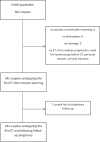'Two countries-two labs': the transnational gamete donation (TGD) programme to support egg donation
- PMID: 33047185
- PMCID: PMC7714895
- DOI: 10.1007/s10815-020-01961-w
'Two countries-two labs': the transnational gamete donation (TGD) programme to support egg donation
Erratum in
-
Correction to: 'Two countries-two labs': the transnational gamete donation (TGD) programme to support egg donation.J Assist Reprod Genet. 2024 Feb;41(2):521. doi: 10.1007/s10815-023-03006-4. J Assist Reprod Genet. 2024. PMID: 38167786 Free PMC article. No abstract available.
Abstract
Purpose: To evaluate the effectiveness, efficiency, and safety of a transnational gamete donation (TGD) programme based on the shipping of vitrified donor oocytes.
Methods: A retro-prospective observational study was conducted in the Assisted Reproductive Technology Center of the University Hospital of Florence, Italy. The study population included 622 consecutive donor oocyte cycles. A mean number of 6 vitrified oocytes per couple were shipped from two Spanish biobanks. In the receiving centre, gametes were warmed and inseminated and the subsequent embryo transfer (ET) was performed. The main outcome measurement was LBR. Secondary outcomes included oocyte survival rate, ICSI damage rate, normal fertilization, cleavage, and implantation rate (IR) in both 'fresh' and cryotransfer cycles.
Results: A total number of 3536 mature oocytes were warmed with 81.4% surviving oocytes. 2PN oocytes were 1941 with an ICSI normal fertilization rate of 70.4% and a cleavage rate of 93.4%; 857 day-3 embryos were transferred in 498 women, 63 blastocysts in 44. Couples with at least one vitrified embryo were 181 (32.3%). IR was 25.1% and 33.1% for day-3 ET and blastocyst stage respectively. Crude pregnancy rate and LBR after the first ET were 35.5% and 27% correspondingly with a conservative cumulative LBR of 34% and an optimal LBR of 51.4%.
Conclusion: Imported vitrified donor oocytes retain their competence and are capable of resulting in ongoing pregnancies and healthy babies in a proportion comparable to other existing systems as egg donation with vitrification/warming in the same laboratory and transnational fresh oocyte donation.
Keywords: Assisted reproduction; Cryo-bank; Cumulative live birth; Egg donation; Infertility; Oocyte vitrification.
Conflict of interest statement
The authors declare that they have no conflict of interest.
Figures


Similar articles
-
Definition of a clinical strategy to enhance the efficacy, efficiency and safety of egg donation cycles with imported vitrified oocytes.Hum Reprod. 2020 Apr 28;35(4):785-795. doi: 10.1093/humrep/deaa009. Hum Reprod. 2020. PMID: 32240287
-
Assessing the effect of below-benchmark vitrified/warmed donor-oocyte survival rates in subsequent laboratory and clinical outcomes.Fertil Steril. 2025 Mar;123(3):448-456. doi: 10.1016/j.fertnstert.2024.09.041. Epub 2024 Sep 29. Fertil Steril. 2025. PMID: 39349121
-
A novel transnational fresh oocyte donation (TOD) program based on transport of frozen sperm and embryos.Hum Reprod. 2019 Feb 1;34(2):285-290. doi: 10.1093/humrep/dey331. Hum Reprod. 2019. PMID: 30520998
-
Fresh oocyte cycles yield improved embryo quality compared with frozen oocyte cycles in an egg-sharing donation programme.Zygote. 2021 Jun;29(3):234-238. doi: 10.1017/S0967199420000842. Epub 2021 Jan 18. Zygote. 2021. PMID: 33455591 Review.
-
Endometrial preparation for women undergoing embryo transfer with frozen embryos or embryos derived from donor oocytes.Cochrane Database Syst Rev. 2020 Oct 28;10(10):CD006359. doi: 10.1002/14651858.CD006359.pub3. Cochrane Database Syst Rev. 2020. PMID: 33112418 Free PMC article.
Cited by
-
Oocyte Cryopreservation - Current Scenario and Future Perspectives: A Narrative Review.J Hum Reprod Sci. 2021 Oct-Dec;14(4):340-349. doi: 10.4103/jhrs.jhrs_173_21. Epub 2021 Dec 31. J Hum Reprod Sci. 2021. PMID: 35197678 Free PMC article. Review.
-
Egg donation in the age of vitrification: A study of egg providers' perceptions and experiences in the UK, Belgium and Spain.Sociol Health Illn. 2023 Feb;45(2):259-278. doi: 10.1111/1467-9566.13590. Epub 2022 Nov 28. Sociol Health Illn. 2023. PMID: 36444136 Free PMC article.
-
The impact of zygote vitrification timing on pregnancy rate in frozen-thawed IVF/ICSI cycles.Front Cell Dev Biol. 2023 Jan 13;11:1095069. doi: 10.3389/fcell.2023.1095069. eCollection 2023. Front Cell Dev Biol. 2023. PMID: 36711030 Free PMC article.
-
Establishment of a Unified Register of Donor Sexual Gametes in the Republic of Kazakhstan.Acta Med Acad. 2024 Apr;53(1):81-89. doi: 10.5644/ama2006-124.436. Acta Med Acad. 2024. PMID: 38629256 Free PMC article. Review.
References
-
- De Geyter C, Calhaz-Jorge C, Kupka MS, Wyns C, Mocanu E, Motrenko T, Scaravelli G, Smeenk J, Vidakovic S, Goossens V. European IVF-monitoring Consortium (EIM) for the European Society of Human Reproduction and Embryology (ESHRE) .ART in Europe, 2015: results generated from European registries by ESHRE. Hum Reprod Open. 2020;24(1):hoz038. doi: 10.1093/hropen/hoz038. - DOI - PMC - PubMed
Publication types
MeSH terms
LinkOut - more resources
Full Text Sources

